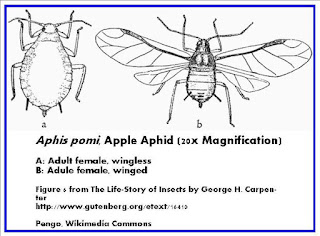Aphids at a glance
Type
of Damage
|
Pierce-sucking
|
Plant
Symptoms
|
Stunted growth, leaf curl, transmit diseases
|
Favourite
Plant
|
All plants
|
Occurrence
|
Year-round in areas with mild winters (SA)
|
Distribution
|
Worldwide
|
Control
|
Difficult, physical preferable, biological
control agents available
|
Aphids are an ubiquitous pest species, if you have ever taken care of a plant – you would have most certainly run into these nasties! I absolutely loathe aphids – my friend could never understand why until she started a vegetable garden herself, now she is as much an aphid hater as me LOL! They multiply at an enormous rate and no plant is beyond their reach, they are equally difficult to control and counteract, especially when tended to by ant herders.
Science Stuff
Aphids belong to eponymous family, Aphididae, contained within the larger order of Hemiptera. They were previously grouped under the order Homoptera, which included soft-bodied insects whose wings are fully membranous, but recently they have been placed with Hemiptera along with insects whose wings are partially hardened elytra. They are placed under the Sub-order; Strenorrhyncha and Superfamily; Aphidoidae.
 |
| Winged Aphid Morphology |
Aphids have a worldwide distribution and can spread passively by wind or through human transportation. About 4400 species are presently described and 250 species are known agricultural pests, allowing the family as a whole to feed on a wide range of plant hosts.
Hosts
Many people believe (me too at some point) that aphids are generalists and feed on whatever plants are available, but strikingly a lot of aphids are monophagous, meaning they are plant species-specific. Hence aphids are named after the host plant they infest, such as the green apple aphid (Aphis pomi) or the common rose aphid (Macrosiphon rosae). To the vegetable gardener aphids can be a huge problem amongst plants of the cabbage family (including Asian greens, cauliflower and broccoli), tamarillos and plants that have been newly transplanted or are still establishing.
During the majority of the aphids’ life cycle they reproduce asexually by means of parthenogenesis and thus offspring are essentially cloned females. Aphids are one of the few insects to bare live young (viviparous) even without prior fertilisation. Aphids produce eggs after sexual reproduction when the host plant becomes crowded or temperatures drop and daylight decreases towards winter. Wingless (clone) females produce sexual male and female clones, these mate and the subsequent eggs overwinter until favourable conditions arise in spring. Winged aphids are also produced during unfavourable conditions and are whisked away by the wind to colonise new plant hosts at a distant site. Aphid populations explode easily due to the high reproductive rate of clone females, which are capable of producing up to 41 generations (each have a lifespan of 20-40 days) leading to thousands of aphids in as little as a month.
Control
Aphids first colonise the underside of plant leaves and then move towards the upper side. Their presence is made known by the curling of leaves and stunted growth of the host, especially new shoots which are easier to pierce with their siphon mouthparts. Feeding aphids reduce the vitality of plant hosts by the removal of plant sap, injecting salivary secretions that suppress host defences and transmission of plant viruses. Aphids produce a sugary waste product (honeydew) that can accumulate on leaf surfaces giving them a shiny appearance and in humid weather this build-up can encourage the growth of black sooty mildew, which weakens the host plant even more.
Be aware that if you do use synthetic chemical control. Most of these products are general insecticides and are harmful to other insects, which do not include pest species. Aphids become resistant to chemical pesticides quite quickly due to their extreme reproductive capacity that allows resistant offspring to multiply quickly. For more information see my post on Pesticide Resistance. Chemical control on the eco-friendly side includes neem or lantana-based products, which can be a bit pricey or hard to find. Homemade soap solutions and horticultural white oil can also be applied to infestations as spray-on applications, but I suspect you would have more success by rubbing the plant down with a soft cloth soaked in the solution and rinsing out the accumulated aphids. Physical control is usually the most effective, but can be time consuming or laborious. Physical control measures includes spraying them with a jet of water, but considering the drought we are experiencing - this might not be preferable. If you don’t mind getting your hands dirty, small infestations can be wiped out by squishing them by hand! You can find my Environmentally Friendly Aphid Control Recipes on my Pest Control Page.
Else you can wait for the natural insect predators of aphids to arrive, but they will likely only do so when you have an infestation of catastrophic proportions! Biological control includes aphids predators, such as jumping spiders, baby mantids, adult lacewings, adult and larval lady bugs as well as the larvae of hoverflies. Please be careful not to destroy already present predators, such as larvae, which are small and sometimes camouflage themselves as pest species. I had a huge infestation of aphids on my fennel one year and decided I was too lazy to spray them the whole time (as eco-friendly controls take multiple applications to work). After some time an army of lady bugs arrived and sorted the aphids in double-quick time – it was quite impressive (and I’ve never had so many ladybugs in my garden before!). You can check out my posts on Biological Control for Ladybeetles, Praying Mantids and Spiders. Other bio-controllers would be parasitic wasps, which you can purchase, but they are more suited to greenhouse release as they fly away easily in open gardens. My Wasp Biological Control post also includes other members that will do away with larger pests such as caterpillars. Having shelter and alternative food plants (for non-predatory lifestages) helps to attract biocontrol agents to your garden, you can have a look at my Insectary Post on how to construct a haven for these insects.
Something Interesting: Aphid Art
Aphids have a mutualistic relationship with ants, this means that both species benefit from the presence of the other, but can also survive and thrive without one another. Ants are herders of many pest species, such as aphids and scale. As aphids feed they produce a sugary waste product known as honeydew, which ants collect as a food source. The ants in turn protect the aphids from predators and some ants even transport aphids between plants for re-establishment when the ants move to new nesting sites. Ants therefore compound the aphid control problem by actively participating in the infestation. Be on the lookout of large masses of ants running the length of your plants as this is indicative of an aphid farm underway. The homemade soap/oil solutions I have suggested should dissuade the ants as well, but since ants are persistent they'll likely re-appear with a new aphid farm in a few weeks. On another note; here is an artist’s illustration on the subject, which I thought was thoroughly amusing.
Related Posts:
Biological Control -
Ladybeetles
Praying Mantis
Spiders
Wasps
Insectary: Beneficial Insects and the Garden Security Force
Pesticide Resistance: Mechanisms & Prevention
______________________________________________________________________________
 |
| Argentine Ants, conquering new niches thru peace and aphid-herding. |
Related Posts:
Biological Control -
Ladybeetles
Praying Mantis
Spiders
Wasps
Insectary: Beneficial Insects and the Garden Security Force
Pesticide Resistance: Mechanisms & Prevention
______________________________________________________________________________
Please share with fellow gardening enthusiasts via the various sharing buttons at the end of posts/pages! Else you can vote for posts through the Google reactions bar at the end of articles. To stay up to date I have provided several reader and social networking platforms with which to subscribe: Twitter, Pinterest, RSS Feed Reader or Email/Follow directly using the Blog Followers widget on the left hand side toolbar. Thank you for reading and please feel free to ask if questions arise - I appreciate comments and ideas too! 😆
_________________________________________________________________________________








